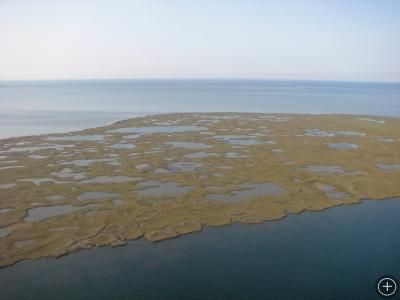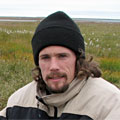Hot Days in the Arctic
OLIKTOK POINT, ALASKA– Last week I made the trip back up to the Arctic coast. Along with two other students from the University of Wyoming who are helping with captures and sample processing, I flew from Denver to Anchorage on Thursday night, then onto Deadhorse the next day. In Deadhorse we met up with a scientist from US Geological Survey and gathered our gear for the drive to Oliktok Point, a US Air Force facility at which we are renting living and working space for this field season.
Outside of Deadhorse, we drove through fields that provide oil which flows through the trans-Alaska pipeline to Valdez. Oliktok is northwest of Deadhorse, and I was told it is the farthest north you can drive in North America. Oliktok Point is a spit of land that juts into the ocean, and the US Air Force maintains a radar site for scanning the skies along the northern coast. The radar site was built during the Cold War, and is one of several such sites scattered along the coasts of Alaska.
Oliktok is much different than either Deadhorse or Kaktovik (a town farther east on the Alaska coast). The radar site is normally operated by crews of 2 people, but rooms and meals can be provided for up to 12. An oil drilling facility is just down the coast, but this area feels much more isolated. The living quarters are in a single long, narrow building that seems like a ship on the inside. All visitors here are required to watch an informational video about polar bear safety. Polar bears are frequently seen in the area and in fact, a tragic attack occurred here in 1993. A polar bear broke through a closed window to attack a man sitting in the living space. The bear mauled the man and other people at the facility were forced to shoot it. You can read the full story here. Since then, precautions have been taken to make the facility safer, such as placing grating over the windows. Such an attack is an incredibly rare event, but serves as a reminder to use caution in the habitats of wild animals.
Skies were blue and temperatures climbed into the upper 60s (Fahrenheit) and maybe even 70s our first several days here. This unseasonable heat felt odd – I expected to be wearing a light winter coat rather than a t-shirt. Yesterday heavy fog and cooler temperatures returned. Hopefully skies will clear and we will be able to fly again tomorrow. The tundra is completely transformed from May, and summer is in full bloom.
Thus far we have caught two adult females, each with twin male cubs. It is great to see bears again. After working with polar bears last August, last October, in the spring this year, and now seeing them again in August, I am beginning to get a better understanding of their annual patterns. For example, their fur is much thinner in August and many bears are still shedding heavily. By October, their fur was deeper, and by spring the fur was quite deep with very distinct layers of coarse guard fur and thick underfur.

 No comments
No comments 








